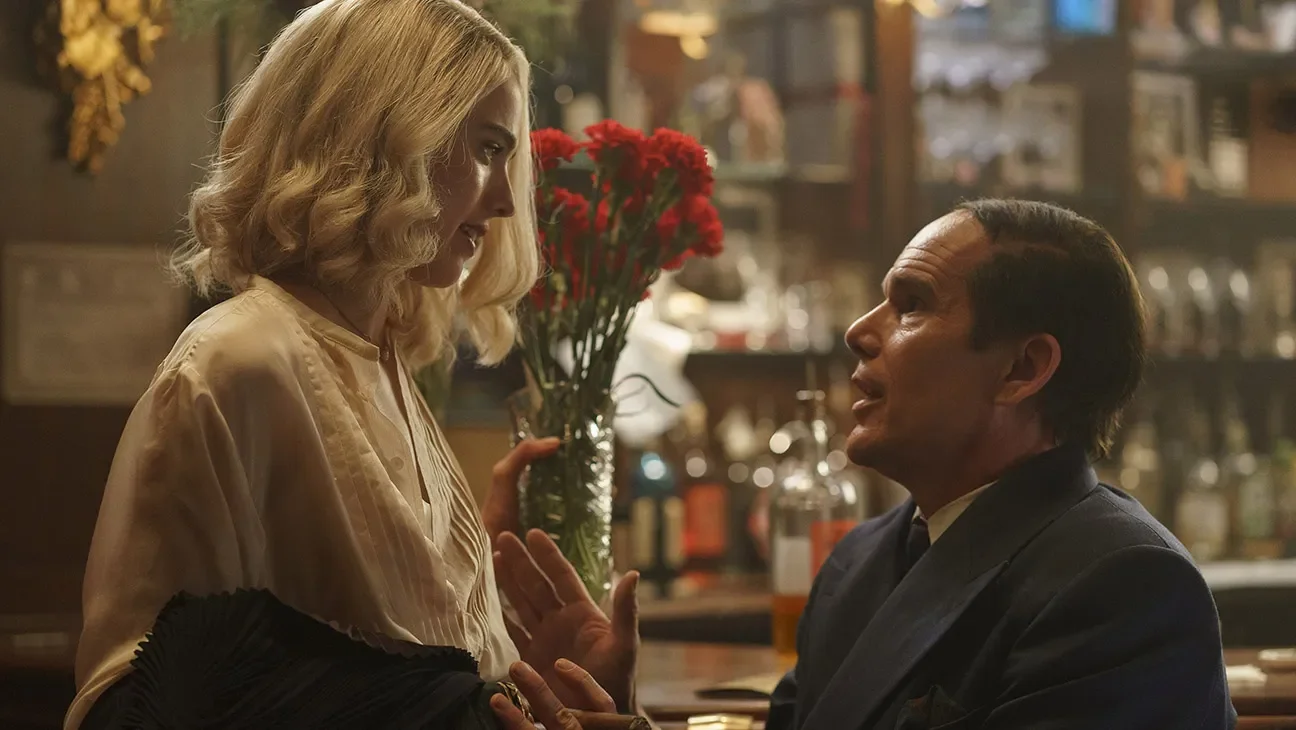‘Blue Moon’ Review: Ethan Hawke and Margaret Qualley Lead a Brilliantly Boozy, Bittersweet Broadway Requiem
Sony Pictures Classics
Richard Linklater stages a masterclass in dialogue and decline with this real-time elegy for Lorenz Hart, elevated by a career-best Ethan Hawke.
Richard Linklater’s Blue Moon opens not with a bang but a murmur; a hushed entrance into Sardi’s on a rainy 1943 night, where a room full of theatrical legends buzz just blocks away from the St. James Theatre, celebrating the historic premiere of Oklahoma!. But our attention, and Linklater’s— is fixed on the man left behind: Lorenz Hart. Once half of Broadway’s most revered songwriting duo, now a washed-up lyricist nursing a bourbon and a wounded ego.
It’s a setting that’s deceptively static, yet emotionally explosive. For the next 100 minutes, we never leave this restaurant. Blue Moon unfolds entirely in real-time and mostly in one location. But with Linklater at the helm and Ethan Hawke in one of his finest performances, what could’ve felt like a confined stageplay instead becomes a vibrant, devastating elegy to collaboration, legacy, and the intoxicating ache of irrelevance.
Lorenz “Larry” Hart (Hawke) is a man out of time— and running out of it. Blue Moon captures him on the very night that Oklahoma! opens without him. Richard Rodgers (Andrew Scott), Hart’s former musical partner of over two decades, has moved on — teaming up with Oscar Hammerstein (Simon Delaney) for a groundbreaking reinvention of the American musical. Hart, meanwhile, is down the street at Sardi’s, drinking, deflecting, and holding court with a tragic wit that cuts sharper than any of his lyrics ever did.
Sony Pictures Classics
In this version of events — scripted with acerbic precision by Robert Kaplow — Hart is fully aware of his place in the room: not on stage, not in the audience, but in the margins. And yet, Hawke gives him the life force of a man refusing to fade quietly. His performance is magnetic, mercurial, and unflinching. There’s a layer of theatrical charm Hart puts on for his companions — a charismatic mask that slips when confronted with the pain of having been left behind.
That pain comes into full view in his interactions with Elizabeth Weiland, a bright-eyed 20-year-old Yale student played with disarming grace by Margaret Qualley. Larry introduces her as his protégée, possibly more. It’s delusional — and Linklater knows it — but Hawke plays the scenes with a tenderness that sidesteps caricature. Their conversations are as much about mentorship as they are about misplaced desire. Elizabeth loves him, just not in that way.
And that, in a sense, is the heart of Blue Moon. A man who’s spent his life writing words of romance and longing is left without either. Hart is gay, unspoken but understood — and the film handles his queerness with a tragic undercurrent that never tips into pity. Instead, we see a man who once lit up marquees now nursing fading dreams, scrounging for scraps of attention from peers, bartenders, and handsome young men delivering flowers.
Sony Pictures Classics
Qualley may have just a handful of scenes, but she haunts the first half of the film through conversations and memories — a ghost of the future Hart knows he’ll never have. Her physical presence on screen is brief but impactful, and Linklater wisely gives her space to shine in a film that’s otherwise word-dense. There’s a sadness behind her admiration, a knowing sympathy that Qualley delivers with subtle emotional control.
Linklater is no stranger to the passage of time, and here he condenses decades of ambition, failure, and affection into one night. Cinematographer Shane F. Kelly glides through the restaurant with the confidence of a dance partner, circling characters as they swirl through joy and regret. There’s a theatricality to the mise-en-scène, but also a remarkable intimacy. One marvels at how still and yet visually alive the film remains, despite its single setting.
What’s especially impressive is the editing — or perhaps lack thereof. With such lengthy, uninterrupted monologues and fast-moving dialogue exchanges, the rhythm feels theatrical and lived-in. Hawke, in particular, delivers some passages that must run close to 20 minutes, each sentence feeling rehearsed but never mechanical. There’s a live-wire energy to the pacing, as if the whole thing might veer off-course if someone misses a beat.
The film's cinematography and production design heighten the intimacy. It’s unclear whether some of the physical staging was achieved via forced perspective or precise blocking, but the result is a masterclass in spatial storytelling. Linklater and Kelly find every possible angle inside Sardi’s without making the film feel over-directed. The camera is often placed at table-level, watching like an invisible dinner guest.
Sony Pictures Classics
The supporting cast shines. Andrew Scott brings quiet dignity and distance as Richard Rodgers, simultaneously celebratory and saddened by his friend’s descent. Bobby Cannavale, as bartender Eddie, is the perfect foil to Hawke’s theatrics — grounded, weary, loyal. Simon Delaney’s Hammerstein arrives like a new lover, gracious but intruding. And a brief cameo by a precocious “Little Stevie” (yes, Sondheim) adds a wink of theatrical lore that will thrill Broadway geeks.
POPULAR ON THE CINEMA GROUP
Kaplow’s dialogue sings. It’s sharp, literate, and often hilarious. Hart’s rants about exclamation points, his critique of Oklahoma!’s sentimentality, his flirtations with waitstaff — they all crackle. But beneath the humor is a man on the edge, one who knows his name may soon be forgotten in the next wave of Broadway history.
What makes Blue Moon so affecting isn’t just the fall from grace — it’s the awareness of it. Hawke plays Hart like a man trying to rehearse joy while mourning his own relevance. He spins stories, tosses quips, flirts with men and women alike, all while his contemporaries toast someone else’s future just across the street.
Sony Pictures Classics
It’s fitting that the film takes its name from one of Hart’s own lyrics, a song about loneliness, change, and unmet desire. There’s a moment late in the film when Hart, eyes glazed and smile trembling, listens to reviews of Oklahoma! being read aloud. His reaction is wordless, but the weight is seismic. It’s not jealousy — it’s the agony of being forgotten.
The final stretch of Blue Moon doesn’t build to a dramatic confrontation. There’s no meltdown, no redemption. Instead, Linklater offers something quieter: acceptance. Elizabeth returns. Larry gets another drink. And life, cruelly and beautifully, goes on without him.
It’s in that stillness — in that melancholy acceptance of time’s tide — that Blue Moon lands its most resonant note. This isn’t just a tribute to a forgotten artist. It’s a meditation on every friendship, every collaboration, every creative bond that fizzles and fractures under the weight of change.
Blue Moon may be modest in scope, but it’s emotionally grand. With career-best work from Hawke, a quietly shattering performance from Qualley, and Linklater at his most poignant, it’s one of the year’s most quietly devastating films.
Rating: ★★★★½
That's A Wrap
|
Blue Moon [2025]
|
That's A Wrap | Blue Moon [2025] |
“Ethan Hawke is extraordinary in Blue Moon, a heartbreaking, booze-soaked tribute to the ones history leaves behind — and the friendships that haunt us long after the curtain falls.”
CREDITS
Screened : Friday, September 27 | Walter Reade Theater | NYFF 63
Cast: Ethan Hawke, Margaret Qualley, Andrew Scott, Bobby Cannavale
Director: Richard Linklater
Screenwriter: Robert Kaplow
Distributor: Sony Pictures Classics
Release Date: in theaters in NY & LA on October 17, nationwide on October 24.
Rating: R


























